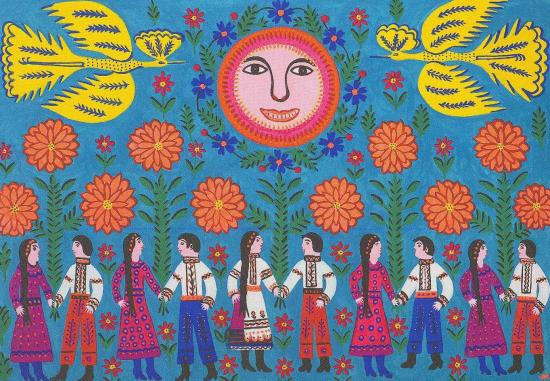-Temporary Exhibit-

Maria Prymachenko, Our Army, Our Protectors (1978). Invading Russian forces destroyed a museum in Ivankiv, a city northwest of the capital Kyiv, that was home to dozens of works by the Ukrainian folk artist Maria Prymachenko, on February 27, 2022.
The Maxwell Museum's Current Issues in Anthropology exhibitions are timely displays that affirm out commitment to share information and create a forum to address current events and issues affecting our region and our world.
Our display near the store of the Maxwell Museum addresses recent events in Ukraine and seeks to share knowledge on Native American and Eastern European historical ties, provoke thought and encourage action.
A Ukrainian Scarf in Native America
Kokum / Masani Scarf (or “Sani”)/ Khutska
These scarves, known by several names, reveal deep connections between Ukraine and Native North America. The origin of this type of scarf, worn by Indigenous people throughout North America, is Eastern European and is most associated with Ukraine, where it is called a “khutska,” “hutska,” or “babushka.” In the 19th century they were produced in Eastern Europe. Today they are typically made in Russia or China and are sold online as either Ukrainian or Native American fashion.
The yellow scarf was purchased at the Kewa gas station on the Kewa (Santo Domingo) Pueblo, as such scarves can often be found in general goods stores in Indian Country. The pink scarf was made in Albuquerque and, as seen for sale online, was labelled a “Navajo Grandma Scarf.” “Masani” means grandmother in Diné Bizaad, or the Navajo language.
The brightly colored floral scarf, known variably in Native America as the “Kokum,” or among the Diné (Navajo) as the “Masani (grandmother) Scarf,” has its origins in Ukraine, where it is known as the “khutska,” “hutska,” or “babushka.”
The scarf made its way to North America with Ukrainian and Russian immigrants who came to Canada and the United States in large numbers in the 1900s, and with the import of Eastern European textiles in the same period. The headscarf, and a larger version sometimes worn as a shawl, were items of trade between Ukrainian-Canadian farmers and members of the Cree Nation in Alberta...
Read the full exhibit text and see its accompanying images in this PDF based on the exhibition.